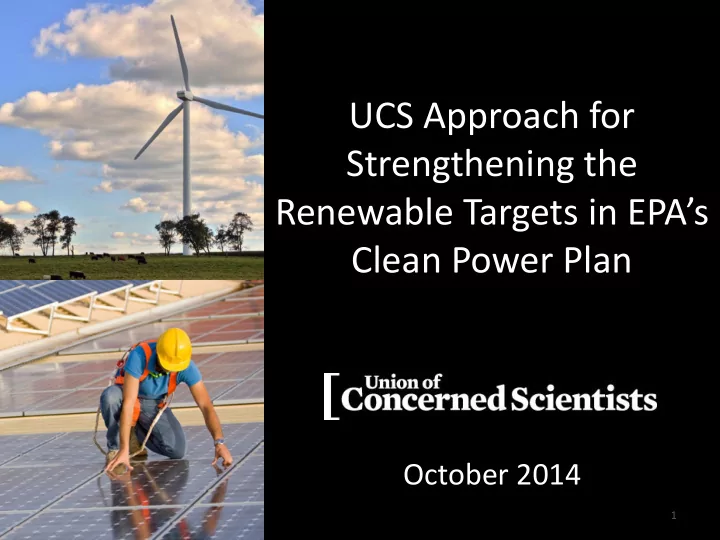

UCS Approach for Strengthening the Renewable Targets in EPA’s Clean Power Plan October 2014 1
Key Takeaways • EPA’s renewable targets are modest • UCS approach improves on EPA’s methodology by building off demonstrated success of leading states • UCS approach leads to more renewables and CO 2 reductions in every region and nearly every state – ~40% national CO 2 reduction below 2005 levels • Defensible and affordable approach for achieving BSER – Minimal effect on electricity prices & lower natural gas prices 2
Power plants are the largest source of U.S. heat-trapping emissions • 40% of CO 2 emissions • 32% of total GHG emissions • A major source of mercury, SO 2 , NOx, particulates, lead...
Impacts of climate change are here… and likely to worsen
Best System of Emission Reduction (BSER) Based on 4 Building Blocks - Improve coal unit heat rate by 6% - Re-dispatch coal to natural gas Boiler NGCC - Increase average NGCC utilization to 70% - Achieve average regional renewable growth targets - Avoid retirement of 6% nuclear fleet - Complete new nuclear in construction - Annual incremental electricity savings rate of 1.5 percent
Adjusted Output-Weighted Average CO2 Emission Rates in Lbs CO2/MWh (fossil emissions) baseline B ASELINE E MISSION R ATE = (fossil generation) baseline + (RE + Nuc) baseline emissions (lbs. CO 2 ) (coal + oil/gas + NGCC + other) baseline = (coal + oil/gas + NGCC + other) baseline + (RE + Nuc) baseline generation (MWh) 2030 S TATE G OAL = re-dispatched fossil CO 2 emissions emissions (lbs. CO 2 ) baseline fossil generation + clean energy goal + EE goal generation (MWh)
EPA Proposed Approach Regional Renewables RPS Target 25% 15% 16% 21% 10% 20% 7 7
EPA’s National Renewables Targets Are Modest EIA Business as Usual EPA Proposed Approach 14% EPA Alternative Approach* 12% 12% 12% % of Electricity Sales 10% 9% 10% 8% 8% 7% 6% 4% 2% 0% 2020 2030 8 *excluding existing hydro
2030 targets in 7 states below 2013 generation levels
2030 targets in 17 states below requirements under existing RES laws Renewable electricity standard EPA target below RES requirement
Demonstrated Renewables Growth Approach • Calculated national benchmark renewables growth rate of 1% of electricity sales/year from 2009-2013 • States below benchmark ramp-up to 1% by 2020 • States at or above benchmark grow at their 5-year average growth rate up to a maximum rate 1.5% • In each year, states achieve greater of growth rate approach or required RPS target • Renewables capped at 40% of electricity sales per state • Added 2013 renewable generation from EIA, distributed PV, and wind & utility solar under construction from 2014-2016 11
UCS vs. EPA National Renewables Targets 25% 23% EIA Business as Usual EPA Proposed Approach 20% UCS Demonstrated Growth Approach % of Electricity Sales 15% 14% 12% 10% 9% 10% 7% 5% 0% 2020 2030 12 *excluding existing hydro
UCS Approach Leads to More Renewables in Every Region (renewable % of electricity sales in 2030) 24% 24% 16% 9% 31% 20% 14% 14% 16% 27% 14% 17% 7% EPA Proposed Approach UCS Demonstrated Growth Approach 13
UCS Approach Requires Only Small Fraction of Renewable Resources Available in Each Region 2.2% 0.2% 1.6% 0.2% 0.5% 0.2% Regional Targets from UCS Demonstrated Growth Approach in 2030 as % of RE Technical Potential
UCS Renewable Energy Targets are Affordable Average Consumer Electricity Price Average Power Sector Natural Gas (2013c/kWh) Price (2013$/million BTU) 12 7 6 10 5 8 4 6 maximum 0.3% increase in 2026 9% reduction by 2030 3 4 2 2 1 0 0 ReEDS Business as Usual UCS Demonstrated Growth Approach
More Renewables Deliver Greater Carbon Reductions 2,500 Power Sector CO 2 Emissions 2,000 (million metric tons) 1,500 1,000 2005 Emissions EPA Modeling of CPP (30% below 2005 levels) 500 Additional Reductions, UCS Demonstrated Growth Approach 0 2016 2018 2020 2022 2024 2026 2028 2030
Deeper Cuts are Needed to Address Climate Change 2,500 2,000 Power Sector CO 2 Emissions (million metric tons) 1,500 1,000 2005 Emissions EPA Modeling of CPP (30% below 2005 levels) 500 Additonal Reductions, UCS Demonstrated Growth Approach NRC Carbon Budget 0 2016 2018 2020 2022 2024 2026 2028 2030
UCS Approach Results in More Wind and Solar PV EPA Proposed Approach UCS Approach Renewables Generation (GWh) Renewables Generation (GWh) 1,000 1,000 900 900 800 800 700 700 600 600 500 500 400 400 300 300 200 200 100 100 0 0 Solar Thermal Solar PV Landfill Gas Biomass Geothermal Wind
19
UCS 2030 Demonstrated Growth Approach Sensitivity Analysis UCS Proposed Demonstrated RE Growth Approach 25.3% 25% 23.1% 23.3% 22.9% No RES Constraint 22.3% 21.9% % of Electricity Sales 20.3% 20% 1% Growth Rate for All States 15% RE Generation Capped at 33% of Electricity Sales No Maximum Cap on State Growth 10% Rate No Cap on RE Genereration 5% No Cap on State Grow Rate or RE 0% Generation 20
Recommendations • EPA should expand the role of renewables in establishing state emissions rate reduction targets • EPA should review and strengthen state emissions reduction and renewables targets by 2025 • States and the EPA should implement measures to prevent double counting of renewables • States should prepare to develop and implement strong compliance plans 21
For More Information Contact: Megan Rising mrising@ucsusa.org More Details and Link to Report: www.ucsusa.org/renewablesandcleanpowerplan Blogs: http://blog.ucsusa.org/epa-clean-power-plan-we-must-do-better-we-can-do- better-683 http://blog.ucsusa.org/epa-clean-power-plan-underestimates-power-of- renewable-energy-to-reduce-carbon-emissions-682 22
Recommend
More recommend